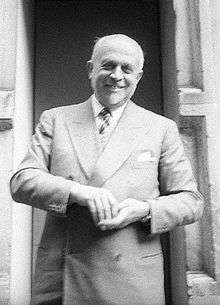Piero Portaluppi

Piero Portaluppi (19 March 1888 in Milan – 6 July 1967) was an Italian architect.[1]

Biography
Piero Portaluppi was born in Milan, son of the engineer Luisa Gadda e Oreste.
He graduated in 1905 from the Istituto tecnico Carlo Cattaneo and registered at the Politecnico, studying along Enrico Agostino Griffini and Carlo Calzecchi. During this time, he worked as a caricaturist, with the satirical newspapers “Il Babau”, “A quel paese” and Il Guerin Meschino.
In September 1910, he graduated as an architect and won the Gold Medal of the College of Engineers and Architects of Milan, as best laureate. For the electrical company Conti, he worked on hydroelectric plants, mostly located in Formazza. The most famous are in Verampio (1912–1917), Valdo (1920–1923), Crevoladossola (1923–1924), Cadarese (1925–1929). For the Azienda Electrica Municipale di Milano, he designed the plant of Grosio (1918–1920). In July 1913, Portaluppi married Lia Baglia. They got three children together: Luisa, Oreste and Tuccio.
During the First World World, Portaluppi was engaged in the military in the Veneto and Friuli Regions. He started again his professional activity after the war, notably rebuilding la Pinacoteca di Brera, the villa Fossati and the Casa degli Atellani in Corso Magenta, house of Ettore Conti. Through Conti, Portaluppi got introduced in the Milan High-Society and started to have big families as clients such as Borletti, Fossati, Venti and Crespi, Angelo Campiglio and Mino Brughera. In 1920, Portaluppi designed two projects emblematic of his architecture; the skyscraper S.K.N.E. for the area of Allabanuel, and an utopian city, Hellytown.
Other projects at this period are the Palazzo della Banca Commerciale Italiana (1928–1932) the Planetarium Hoepli (1929–1930), and residential buildings for the Buonarroti-Carpaccio-Giotto family (1926–1930), the house Crespi on corso Venezia (1927–1930), the palazzo Crespi on piazza Crispi (1928–1932). He designed the Italian Pavilion for the Universal Exposition in Barcelona in 1929. Between 1934 and 1938, he engaged in restoration works on the Church of Santa Maria delle Grazie, continued after the war. Among his most important works are the Palazzo INA, piazza Diaz (1932–1937), the villa Necchi-Campiglio[2] (1932–1935), the palazzo Ras on via Torino (1935–1938). The Second World War marks a dramatic moment, with the death of his son Tuccio. He become more engaged after the War in teaching activities and representatives functions. He collaborated in later works with Gio Ponti (1956–1962). On 6 July 1967, Piero Portaluppi dies in his house on corso Magenta in Milan.
Publications (in Italian)
- Piero Portaluppi, Aedilitia I, Bestetti e Tumminelli, Milano-Roma 1924.
- Piero Portaluppi, Marco Semenza, Milano com'è ora come sarà, Bestetti e Tumminelli, Milano-Roma 1927.
- Piero Portaluppi, Aedilitia II, Bestetti e Tumminelli, Milano-Roma 1930.
References
- ↑ Piero Portaluppi – itinerari – Ordine degli architetti, P.P.C della provincia di Milano. Ordinearchitetti.mi.it. Retrieved on 3 July 2015.
- ↑ Villa Necchi Campiglio, Milan by Piero Portaluppi |. Catesthill.com (28 January 2014). Retrieved on 2015-07-03.
External links
| Wikimedia Commons has media related to Piero Portaluppi. |
- Piero Portaluppi Foundation Official site
- Catalogo della mostra Piero Portaluppi – Linea errante nell’architettura del Novecento
- Portaluppi, Piero entry (Italian) in the Enciclopedia italiana
|